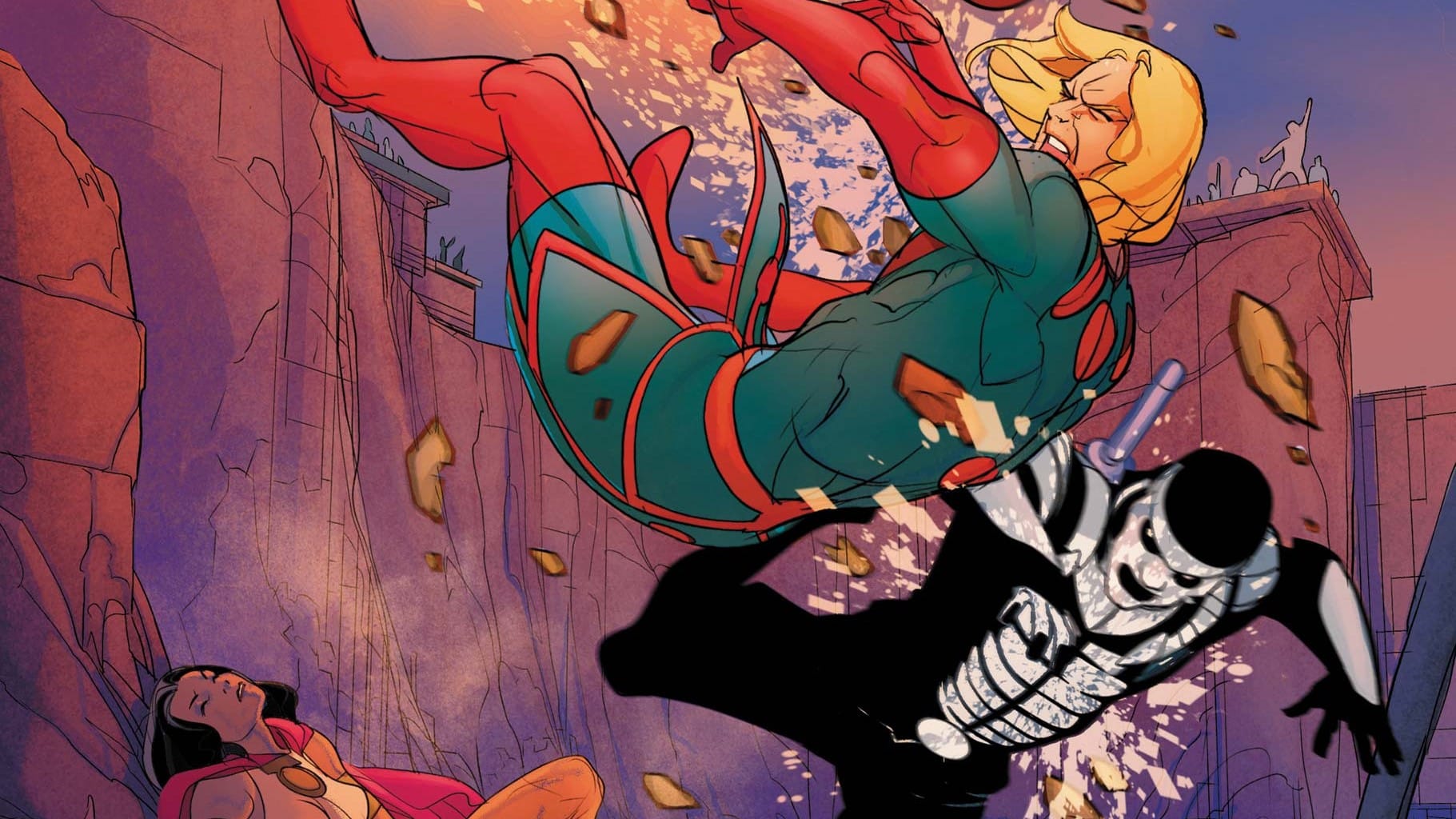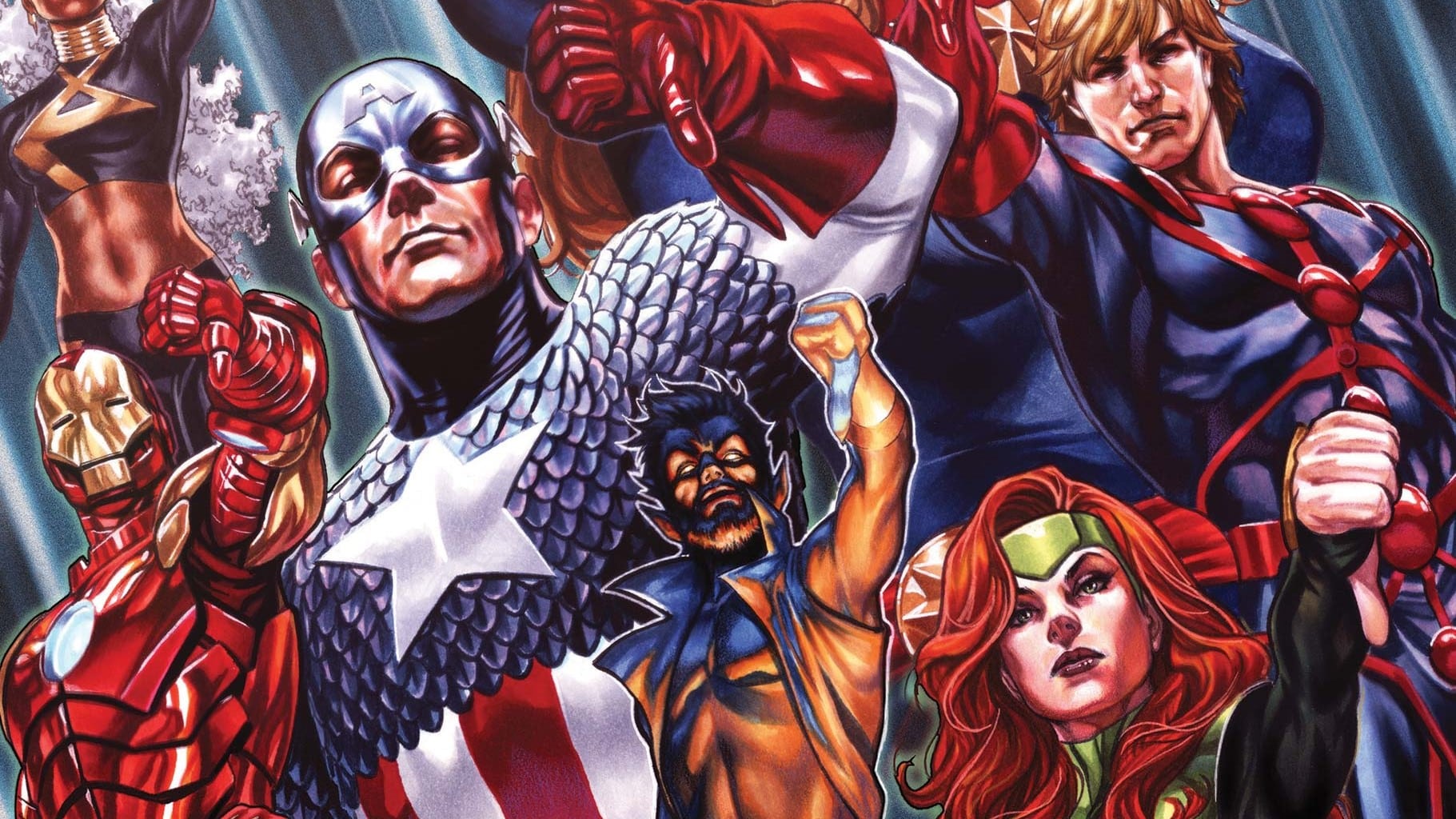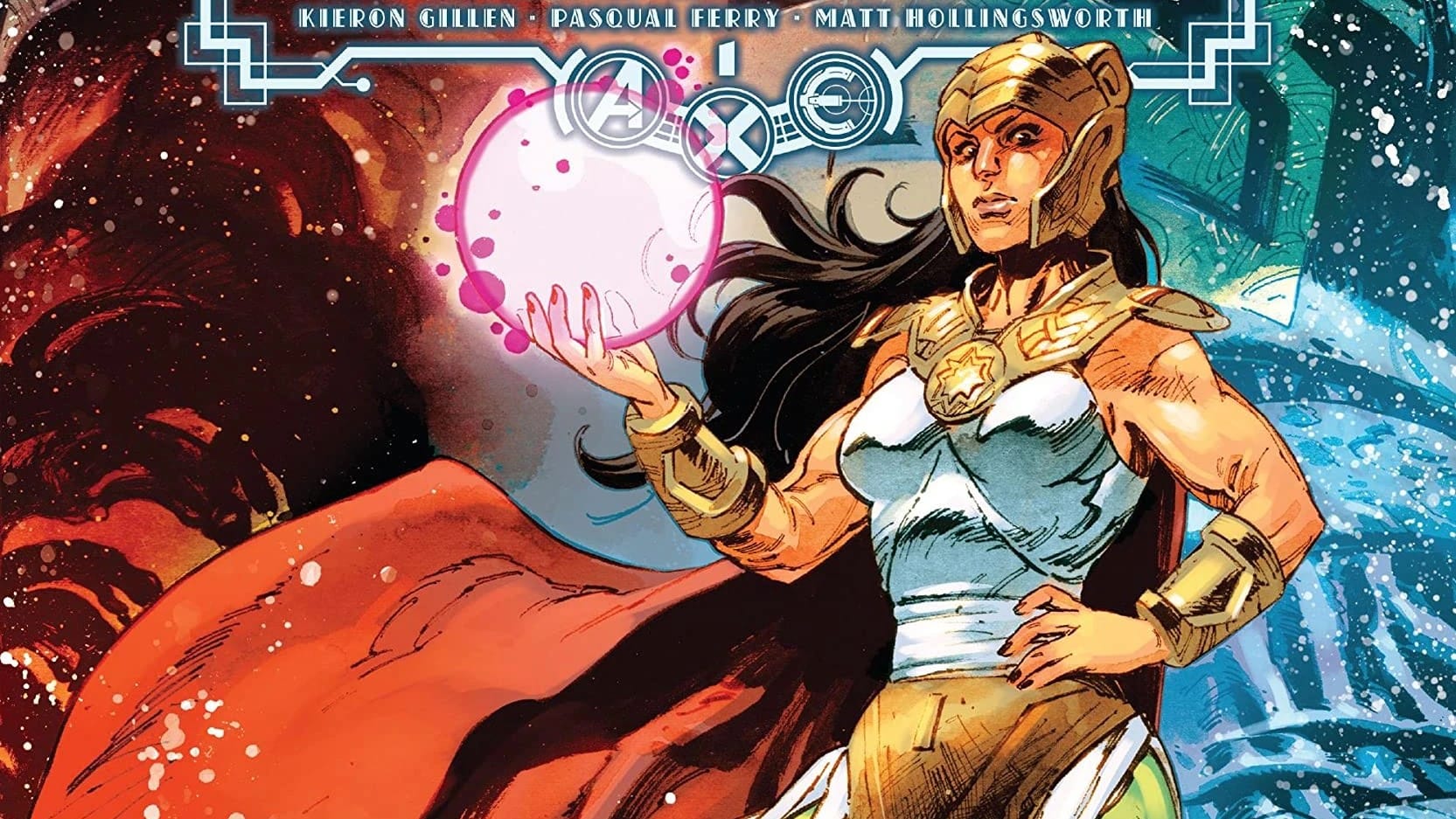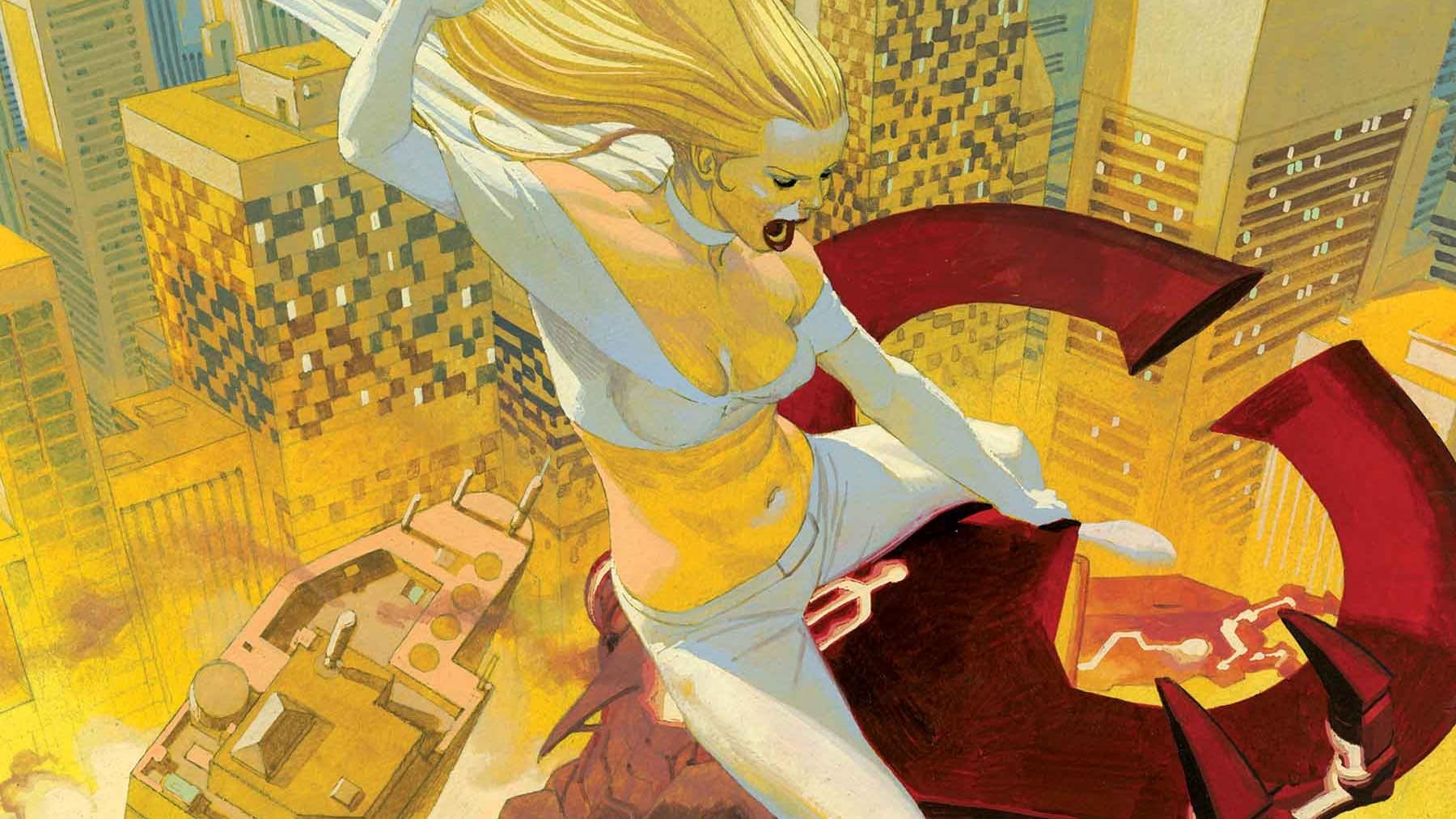In this installment, The X-Men fight giant monsters, unwittingly allowing Tony Stark ample time to build a god in his own image. This will surely end well. A.X.E.: Judgment Day #2 is written by Kieron Gillen, drawn by Valerio Schiti, colored by Marte Gracia and lettered by Clayton Cowles.
Sean: Salutations, True Believers! It’s ya pal, Smilin’ Sean Dillon, here with Rambunctious Rasmus Lykke to talk to you about the death-defying adventures of the Avengers and X-Men as they face off against the nefarious Eternal weapon known only as … THE HEX!!!
Rasmus: Excelsior!
What an issue! I thought it’d take longer until we reached such a big turning point in the series, but things are moving fast. By the end of the issue, the event series has taken a drastic turn away from what it appeared to be heading toward in the first issue.
But before that dramatic reveal, there’s an entire issue of exciting events to take in.
A Poison Tree
Sean: The main crux of the issue is one massive fight scene between the X-Men and Avengers and the Hex. And boy is this something truly spectacular. Schiti does a fantastic job portraying the massive scale and impact of this battle. Just the sheer scope of the fight’s impact alone is truly spectacular. Just look at the detail put on the tidal wave as the crab Hex punches the ocean!
Rasmus: It is really amazing work. And it’s not only the sheer scale of the battle, he also nails the little moments in the issue. The scene with Sinister, Ajak, Makkari and Iron Man has some lovely acting in it as well, making the characters come to life for us.
Equally lovely is the work by Marte Garcia. He’s selling the explosive action, the otherworldliness of the Hex, the colorful costumes and powers of the heroes. And he also makes sure to contrast these blockbuster moments with a more muted palette in the quieter moments.
It’s an art team that’s working in perfect unison — something that, surprisingly enough, the X-Men and the Avengers also manage fairly well in the fight.
Sean: Equally, there’s the narration. Typically in these types of stories, a narrator can become overwhelming and exhausting, highlighting details that make the events feel more portentous and pretentious than they ought to be. But here, Gillen is able to capture the scope of the moment in short and sweet text boxes that highlight the full implication of what’s happening.
Look at the way he has Syne the Memotaur feel small and helpless with just two words contrasted by a massive explosion. We don’t even see a visual of the moment, not even the words spoken by Syne in her final moments. We only see our narrator’s accounting of them.
In contrast, we see Exodus die a brutal and painful death. We see his scream of anguish come from his mouth. We are closer to the religious zealot than the giant monster he fights. And yet, there’s something, for want of a better term, human about the plea for mercy. Not even a cry or a beg. A simple “Please don’t.” like the Eternal was being asked to have the entire history of the X-Men explained to them.
Rasmus: I actually felt more for the Hex than Exodus in that moment. He’s a zealot, certain in his righteousness. She’s merely being used as a weapon. She doesn’t know what’s going on and is grasping at meaning and then mercy.
And her death is meaningful. Exodus simply returns, with no cost. Syne the Memotaur’s resurrection, however, has a high cost. Being Eternal means that to be brought back requires the Machine to take a human life. And thus it becomes clear(er) what role the six humans introduced on the very first page of the issue play.
The Human Abstract
Sean: The humans are a fascinating portrait in the Marvel Universe. Typically when non-superpowered players are involved in the narrative (and especially X-Men stories), it’s to act as a moral vacuum to contrast the nobility of the heroes. Be it the various people waving “MUTANTS DIE” signs or the folks on the street telling Spider-Man to piss off, humanity isn’t often highlighted in the best light in the Marvel Universe.
By contrast, the six snapshots of humanity we’re presented highlight a variety of perspectives. There are some who have contempt for the mutants or are simply nonplussed by them. But there’s also a perspective I’ve not often seen: remorseful.
We’re introduced to Jada in the first issue as someone who has … issues with the mutants’ resurrection policy only affecting mutants, but her presence here shows a degree of change (even if it’s not complete) regarding her discomfort toward her fellow protesters’ willingness to get on board the genocide train.
Which makes the ultimate nature of the six all the more horrific.
Rasmus: While the connection between the humans and the Eternals might not be immediately clear when we first encounter them (which is technically the cast page), in retrospect it appears to be quite simple. Syne is above Arjun, so when she dies and is brought back, he dies. A normal human death, without any way to return to life.
As the narration reminds us, this is the Eternals’ secret. Because while it’s news that the mutants have defeated death, it’s long been a cornerstone of the Eternals. And given the spotlight on the humans, I strongly suspect it won’t be a secret for long.
Humanity may’ve been mad at the mutants for having kept resurrection secret. I doubt they’ll look kindly on a group of beings that actually cause humans to die.
Sean: Yeah, the base concept of the Eternals resulting in people dying is kinda fucked. This is not going to end well for anyone.
Rasmus: A Gillen classic!
Sean: Yeah, Gillen is often interested in the ways in which powers fuck things up for everyone involved. The obvious one is The Wicked + The Divine, where artists as gods result in fire, death, fascism and Woden. Über is about superheroes as the Bomb and the wrath they encur upon World War II. Even more pop Marvel work like Young Avengers centralizes events around the misuse and attempt to control the Demiurge.
But I think this might be the first time Gillen has explored the implications in long form on a religious level. Not simply a one-shot like the 1373 WicDiv issue or the penultimate issue of Uncanny X-Men that’s also a Dr. Manhattan riff. But rather what it means for the gods and angels to enact horror upon mankind. To be responsible for their deaths and suffering.
Rasmus: It’s interesting, because I think that for much of the buildup, tie-ins and even the first two issues here, the focus of the series has clearly been on the “others.” The first issue focused on the Eternals, and this one is mostly about the X-Men defending their home. But given the expanded role that humanity is indicated to play going forward, the Avengers are bound to take a more prominent role.
This issue really upends a lot of, at least my, expectations for the event. It appeared to be the Eternals fighting the X-Men, with the Avengers caught in the middle. But with hints at the Eternals’ secret being exposed, it may just shift and it’s the X-Men fighting the Eternals, with the Avengers caught in the middle.
Or it might be, if noted Avenger Tony Stark (and Ajak, Makkari and Mr. Sinister) hadn’t brought a dead Celestial back to life.
A Divine Image
Sean: Has there ever been a time when Tony Stark has done something for the betterment of mankind, only for it to blow up in his face? There was the time he took over the world, only to let Norman Osborn steal it from him. The several times where he’s become a god, or godlike, only for it to go to his head. And now he’s built a God and modeled it after himself (in a moment explicitly tied to Ultron), and lo and behold, it wants to kill everyone!
Rasmus: The entire sequence of the Celestial being put together was wonderfully foreboding and tense. Even before we got to the “Just like Hank and Ultron, right?” joke from Tony, it was clear this wasn’t going to end well for anyone.
Though, to be fair, the idea does seem to make sense on the surface. The Eternals are acting out, doing bad things. Let’s call their parents.
Hell, the plan may’ve even worked, if it wasn’t executed by a group of people that have, historically, all shown incredibly bad judgment.
Sean: You have two religious zealots who have just learned that they’re the flaw in God’s plan, a man whose ego has destroyed galaxies and who thinks he was right regardless of the casualties, and Mr. Eugenics himself. It’s a shock that everyone else didn’t think to go, “This is going to blow up in our faces, isn’t it?”
But it’s the way it blows up in their faces that’s truly interesting and ties into the role of the six humans beyond being sacrifices to continue the Eternal Machine. Rather than the traditional “Kill them all and replace them with robots” plan an Ultron would have or Thanos’ “I’m a sensitive lover who wants to bone Death; genocide is my way of giving my girl roses” plan, God has decided to Judge everyone on Earth. If everyone doesn’t meet God’s standards, then they will have no tomorrow.
So that’s Earth doomed.
Rasmus: Yup!
It’s interesting, because what are our heroes going to do? Yeah, sure, they can beat God/the Celestial until it goes away. But that’s lame and boring and not what’s going to happen. So how the hell are they going to win? What can they do to prove that the people of Earth are worth saving? Is it all going to end with Scott Summers showing God the Good Place?
Another interesting fact is that we (as readers) are just going along with it. Sure, the big scary monster says we’ve ruined the Earth, but that doesn’t necessarily mean it’s true. Yet we’re all going along with it, nodding our heads, “Yeah, he’s right. Some of us are good, but the majority are really shit.” Which says a lot about our times, I think.
It’s an interesting wrinkle and something I’m excited to see how Gillen and the rest of the team pull off, because I don’t see a major Marvel event ending with a “yes” to the question that Gillen has mentioned as the major theme for the series: “Are we just fucked?”
Sean: It could be a yes, but it could be a qualified one with the core being “Given that.” Considering the mention of destroying the environment, there is a degree to which humanity has doomed itself. The failures of systems (or, perhaps more accurately, the consequence of their success) highlights this aspect of humanity being fucked.
In some regards, that’s actually the core theme of Hickman’s HoXPoX: What do you do when you know that you always lose? That no matter what plans for a better future you lay out, no matter how many times you achieve a utopian society, it’s always going to end with everything lit aflame in an inferno. What’s the next step from “God is disappointed in you?” Where do you go from that?
Rasmus: Guess we’ll find out in two weeks!
(Or more probable, in November, when the series ends).
Jury Box
- Every face Mr. Sinister gives in this book is amazing. Just so punchable, so smug, so perfect.
- Valerio Schiti’s designs for the Hex are all marvelous. They’re so weird, primordial and otherworldly, while also simply being scary AF (as the kids say).
- The moment where Destiny tells her son, “That is accurate, child. I see the future. And I remember the past. We stand alone. We always did.” Chef’s kiss!
- But it’s not even true! The Avengers were there, helping. And they don’t just leave, Cyclops tells them to go. Scott’s just the only one who appears to know. … I hope nothing happens to him.
- The inability to deal with cosmic horror and mass death in the wake of doing a 9-5 job and just focusing on staying alive is a mood.
- Likewise, wow do I see a lot of people thinking just tweeting is enough. On the other hand, there is power in knowing you’re not alone. Everyone is important.
- Oh god, “Everyone is important,” one of fiction’s great lines of hope, being turned into a source of horror, is just brilliant.
- This event truly is Peak Gillen™.







